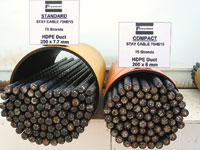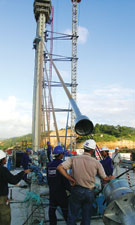 |
| Slimmed Down. Smaller profile reduces wind loading. (Photo courtesy of Freyssinet S.A.) |
By cramming the same amount of stay cable steel into 35% less space, builders of a record-breaking bridge in Vietnam can satisfy higher than planned wind speeds without late structural changes. Developed for the worlds longest centrally supported, concrete cable-stayed Bai Chay Bridge, the "compact duct" system came too late to help designers of the vast Stonecutters crossing in Hong Kong.
To straddle Rambler Channel with a 1,018-meter main span, Hong Kongs $350-million Stonecutters Bridge will be wide open to typhoons. With its stays exerting high wind forces, the designers had to specify parallel wire cables rather than the fatter strand option, says Naeem Hussain, a director of lead designer Ove Arup and Partners Hong Kong Ltd.
That decision meant sacrificing advantages of parallel strand cable, says Hussain. They include easier strand-by-strand installation and replacement, as well as added corrosion protection. Since then, however, stay cable makers "have come up with new systems," he adds.
 |  |
| Aerodynamic. Vietnams Bai Chay Bridge is the first to use the slimmer cable casing design. (Photos by Peter Reina for ENR) | |
Vietnams 901-m-long Bai Chay Bridge is a pioneer of one such compact cable design, claims Paris-based Freyssinet S.A. Under a $10.5-million subcontract on the bridge, the company is supplying and installing centrally located fans of 28 cables, up to 230 m long and containing 37 to 75 strands each.
With 137-m-tall towers, Bai Chay has a 345-m cast-in-place main span. Its 3.65-m-deep deck box is braced internally with diagonal steel tubes about 25 centimeters wide. Each 6.5-m-long deck section has two pairs of tubes. One pair is square and prestressed at stay locations. The other set is circular and unstressed.
A consortium of Japan Bridge & Structure Institute Inc., Pacific Consultants International, Transport Engineering Design Incorporation and Hyder Consulting-CDC Ltd. completed the bridges design six years ago, says Haruo Yanagawa, design team project manager.
But in 2004, the owner ordered a hike in wind speed from about 45 m per sec to 50 mps. By then, the main foundations already had been built, says Naoki Nagamoto, a senior designer with the prime contractor, the Shimizu-Sumitomo Mitsui Joint Operation (SSJV). "We could not change the dimensions of the tower," says Nagamoto. More vertical prestressing helped. But by using smaller cable ducts, "We could reduce forces on the stays...to 80%," he adds.
Having already signed its cable contract, Freyssinet moved fast to produce slimmer ducts containing the same number of strands, says Roger Raymond, the companys director for Vietnam. The firm slimmed 25-cm-diameter stays by 20% and reduced 16-cm-diameter units by 10 cm, he adds. To maximize room in the compact casings, Freyssinet trimmed 20% from the 1.5-millimeter-thick anti-corrosion strand coating. And it even shaved off internal fillets left from welding casing sections together.
Freyssinet also developed a slim shuttle to thread the last 10 or so strands individually up each tightly packed duct. For the rest, erectors use a standard shuttle that rides a guide wire carrying two stands. "The system was tested in [full-scale] mock-up and now we are improving it," says Alain Granet, Freyssinet's site manager. Developing compact ducts added about $500,000 to the cable contract, says Raymond.
Crossing an inlet at Bai Chay near coastal Ha Long City, the bridge will fill a gap on the 320-km Highway 18 running east from Hanoi airport and turning north at the coast, to Chinas border. Construction bidding was limited to Japanese firms as the Japan Bank for International Cooperations financing was a tied loan, says Yanagawa.
SSJV signed its design check and construction contract for about $63 million in May 2003. Under a roughly $10-million subcontract, Shairaishi Corp., Tokyo, began foundation work in August 2003, completing main caissons within a year. The 47.5-m-tall main piers are founded on pneumatic caissons, the larger one having 20-m sides and reaching 26 m below water, says Yanagawa.
Aiming for an early completion next September, the contractor is casting deck boxes on a nine-day cycle. Thats good progress for Vietnam, says Yanagawa. But the pace is leisurely for Freyssinet, says production manager Craig Robertson.
Bai Chays last cable is due for placing next April. After that, "I feel the compact duct will be more and more used," says Roger. That might be so, but not at...

Post a comment to this article
Report Abusive Comment